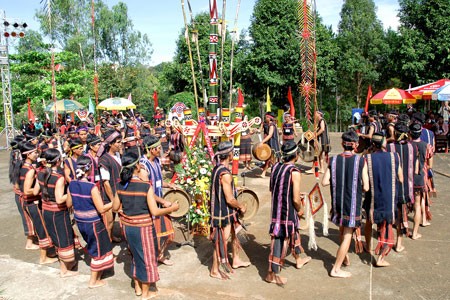(VOVworld) – The Ede epic, a true product of the farming civilization, is a long story in verses and rhythm. Most famous Ede epics are Dam San and Xinh Nha.
 |
| Gongs performance in the Central Highlands (Photo: baogialai.com.vn) |
The popular Dam San epic of the Ede in the Central Highlands tells the story of Dam San, a heroic fighter against customary laws. To be come the head of his tribe, Dam San was supposed to leave his girlfriend H’Bia Diet Klut to marry the two wives of his grandfather – H’Nhi and H’Bhi. Defying this rule, Dam San went to the heaven to file the petition. He challenged the old customs by marrying the Goddess of the Sun and defying the Ede’s matriarchy. The Xinh Nha epic depicts a Central Highland hero who fought against cruelty with a mighty storm and brought happiness to villagers. Both epics are included in tertiary curriculums. Researcher Linh Nga Nie Kdam told VOV: “Epics are long rhyming novels created by folk artists a long time ago. A story may contain thousands of pages and hundreds of characters who appear on 4 levels of space: in the sky, on the earth, underground, and underwater. Stories are recited to the accompaniment of music. They vividly reflect the customs and habits of life in the Ede hamlets”.
 |
| Researcher Linh Nga Nie Kdam |
Most Ede epics originate from folklore and are passed down from generation to generation orally or in writing. Some works can be recited in one or two nights, but others may last 4 or 5 nights, depending on the mood of the tellers. Researcher Linh Nga Nie Kdam again: “The local people used to live in isolated areas, so epic telling was almost the sole means of entertainment for ethnic minority people in the Central Highlands, including the Ede. On rainy days, post-harvest days, or during festivals, epics are recited. Sometimes, artists are invited to rice fields to entertain farmers working there”.
The Ede epic performers are respected because they are believed to be blessed with special abilities and considered “living treasures” of the nation. These talented artists help create various versions of the Ede epics, enriching the local folklore.
In an effort to preserve the Central Highlands epics, in 2007 the Ministry of Culture, Sports and Tourism launched a campaign to collect epic songs, which will be digitized. 33 Ede epics have been classified. Festivals and concerts have seen more epic performances. When an epic recitation echoes from an Ede long house, the story will be remembered and promoted.